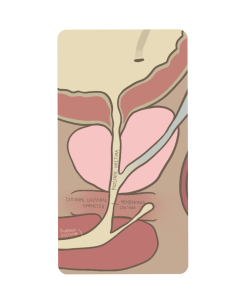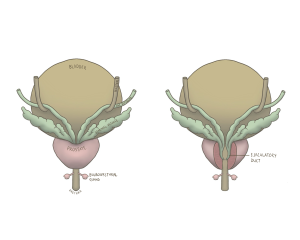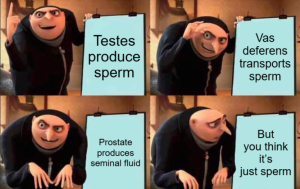26 Male Pelvic Viscera
Male Pelvic Viscera:
The ureters, bladder, prostate, urethra, prostate gland, seminal vesicles, are part of the urogenital system and they, along with the terminal parts of the digestive tract, make up the pelvic viscera. The urogenital organs work together to manage urine storage, urination, as well as semen production and ejaculation.
Table 28 Male pelvic viscera
| Organ | Function |
| Testes | Produce sperm and testosterone. |
| Vas Deferens | Transports sperm from the testes to the urethra |
| Seminal vesicle | Add a sugary media that provides energy for sperm |
| Prostate | Produces fluid that nourishes and protects sperm |
| Bulbourethral Glands | Release a lubricating fluid to aid sperm movement |
Figure 64 Anterior view(left) and Sagittal view(right) of male pelvic viscera
Urethra:
In males, the urethra serves a dual purpose of transporting urine from the bladder and transporting semen during ejaculation. The urethra can be divided into three segments:
Table 29 Male urethras
| Organ | Function |
| Prostatic Urethra | This section passes through the prostate gland, allowing fluids from the prostate to mix with sperm. |
| Membranous Urethra | This short, narrow section passes through the pelvic floor muscles, helping to control urine flow. |
| Spongy (Penile) Urethra | This section runs through the penis and carries both urine and semen out of the body. |

Figure 65 Sagittal view of male urethras

Figure 66 Zoomed sagittal view of the male urethras
Prostate:
The prostate is a gland located just below the bladder. It adds secretions to the semen which nourish and aid in the transportation of sperm.
Epididymis:
The epididymis is a long and coiled tube located on the back of the testes, that stores and matures the sperm produced in the testes.
Seminal vesicles:
The seminal vesicles are located posterior to the bladder and superior to the prostate. They produce a fluid rich in fructose, a source of energy for sperm. The seminal vesicles also connect to the vas deferens to form the ejaculatory duct which then enters the prostatic urethra and provides an entry point for semen to flow through the penis.
 Figure 67 Posterior view of the male pelvic viscera with (left) and without (right) a cut-out of the ejaculatory duct
Figure 67 Posterior view of the male pelvic viscera with (left) and without (right) a cut-out of the ejaculatory duct
Do you remember the major players in the male reproductive system?

Hint: This meme is referencing the fact that semen is composed of many different things, including seminal fluid!

